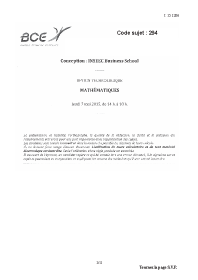1) Etudier des intégrales convergentes
Définition :
Soient a∈R et b∈R∪{+∞} avec a<b.
Soit f:[a,b[→K continue par morceaux.
L’intégrale de f sur [a ;b[ converge si ∫xaf(t)dt converge quand x→b−
Dans ce cas, ∫[a ; b[f(t)dt=∫baf(t)dt=limx→b−∫xaf(t)dt.
Définition :
Soient a∈R∪{−∞} et b∈R avec a<b.
Soit f:]a,b]→K continue par morceaux.
L’intégrale de f sur ]a ;b] converge si ∫bxf(t)dt converge quand x→a+.
Dans ce cas, ∫]a ; b]f(t)dt=∫baf(t)dt=limx→a+∫bxf(t)dt.
Définition :
Soient a∈R∪{−∞} et b∈R∪{+∞}.
Soit f:]a ; b[→R continue par morceaux.
L’intégrale de f sur ]a ;b[ converge si pour c∈]a ;b[, les intégrales de f sur ]a ;c] et sur [c ;b[ convergent
Dans ce cas, ∫]a ; b[f=∫]a ; c]f+∫[c ; b[f.
Propriétés :
Soient f,g:I→K continues par morceaux avec I intervalle de R.
Théorème de comparaison de fonctions positives :
Soient f,g:[a ;+∞[→R continues par morceaux avec 0≤f≤g.
Si ∫+∞ag converge alors ∫+∞af converge.
Si ∫+∞af diverge alors ∫+∞ag diverge.
Théorème : Relation de Chasles
Soit f:I→C continue par morceaux telle que ∫If converge.
Pour tous a,b,c éléments ou extrémités de I :
∫baf(t)dt=∫caf(t)dt+∫bcf(t)dt
Et les intégrales convergent.
2) Critères d'intégrabilité
Théorème :
Soit f:I→R continue par morceaux et positive.
Il y a équivalence entre les propositions suivantes :
Théorème :
Soient f:I→R et g:I→R+ continues par morceaux.
Si pour tout t∈I, |f(t)|≤g(t) avec g intégrable alors f est intégrable.




